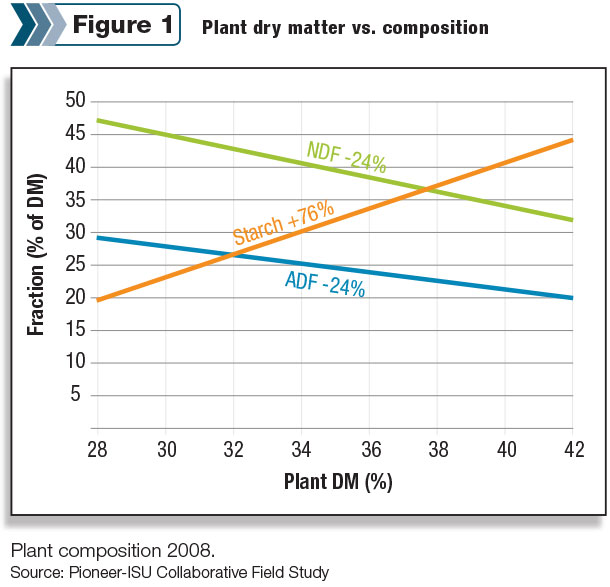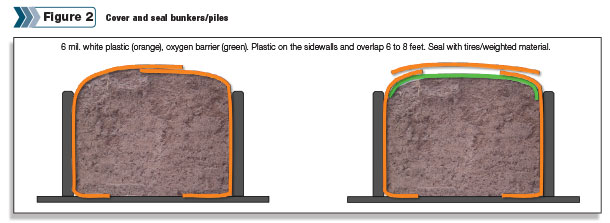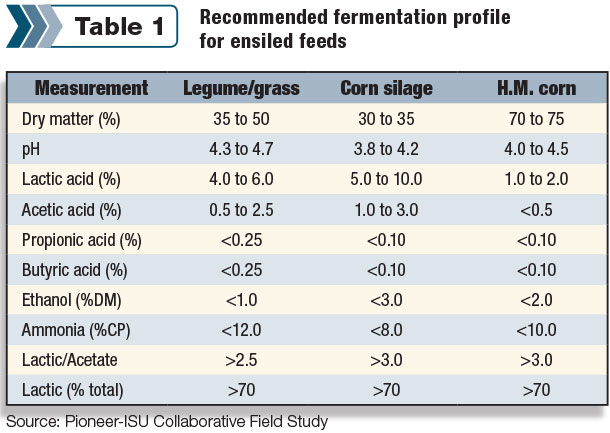It’s time to get ready for harvesting 2015 corn silage, as the crop has an early start in many areas of the U.S. With current corn prices, corn silage may be the most economical forage source available to your dairy herd. The following checklist can lead to a successful harvest session.
1.Be ready when your corn silage has reached an optimal level of dry matter to ensure desirable silage fermentation and compaction. For bunkers, piles and bags, target 32 to 35 percent dry matter.
Milk line can be used at half to three-quarter milk line (the position of the solid starch from the kernel top to the down attachment to the cob to where the starch meets the liquid milk phase) but depends on moisture in the field and drydown. Milk line may not be the best indicator of when to chop.
2.Be aware of the relationship of plant dry matter and maturity as starch levels increase, as illustrated in Figure 1. If you delay harvest to achieve higher starch levels in your corn silage, you must process corn kernels to avoid the passage of harder starch particles. Additional packing may be needed to achieve the desired corn silage density.

3.Kernel processing is critical, especially with hybrids that have hard and dense starch forms. All kernels should be damaged with kernels broken into four pieces (quartered) or finer. Two ways to evaluate corn silage as it comes from the field are listed below:
- Take a 32-ounce cup of corn silage before ensiling and spread it out and check the processing of the corn kernels.
- Take two or three handfuls of corn silage, place in a bucket of water, skim off the floating corn plant material, pour off the water and evaluate the corn particles left in the bottom of the pan.
4.Be sure to add a research-based silage inoculant. Published research summaries report a 3 percent increase in dry matter recovery and an increase of 2 percent in energy content as the fermentation is optimized. The benefit-to-cost ratio is 3-to-1 in nutrient recovery.
Corn silage inoculants may contain bacteria that produce acetic acid along with lactic acid to prevent secondary fermentation during feedout and enzymes that can break down fiber, resulting in a higher-energy-content corn silage.
5.Target corn silage density to exceed 15 pounds of dry matter per cubic foot in storage. This can be a challenge for bags and drier corn silage. Wisconsin guidelines are listed below:
- Tractor weight in pounds / 800 pounds equals tons per hour that can be packed correctly
- Example: 30,000-pound tractor / 800 pounds = 37.5 tons of corn silage per hour with this tractor
Tower and upright silos have an advantage as vertical pressure presses oxygen out of the corn silage. If the corn silage is stored in silos less than 60 feet in height, chopping at 32 to 34 percent dry matter is recommended, while taller silos may need to be chopped at 35 to 37 percent dry matter to avoid excessive seepage. (Seepage contains 5 to 8 percent dry matter content.)
Chopping wetter silage to “top off” the final 10 feet of a tower silo can reduce spoilage at the surface of the silo. Some farmers may cover the top of the silo with plastic to reduce oxygen penetration or use an additive to reduce mold formation with organic acids.
6.Cover bunkers and piles with a layer of oxygen-barrier film and cover with overlapping plastic that lines the interior wall before covering with oxygen-barrier film (Figure 2).

Researchers report an overall 2 to 5 percent improvement in dry matter recovery in the entire storage unit with significant dry matter saving in the top 3 feet. If an oxygen barrier is not possible, commercial products and organic acids can reduce mold formation and improve dry matter recovery.
7.Check the fermentation profile of your corn silage to determine if your corn silage has an optimal fermentation pattern. Table 1 lists the desired silage pH, level of organic acids (lactic, acetic, butyric and propionic acids), ammonia nitrogen (more important with haylage) and ethanol (not desired). Using a research-based inoculant will enhance your fermentation profile along with optimal packing and filling rates.

8.Calculate the amount of corn silage you will need for the 2015-2016 feeding year. Be sure to have enough 2015 corn silage to reach to December of 2016. Research has reported that corn silage increases in feed value (more energy per pound of dry matter) if corn silage has been allowed to ferment for 3 to 5 months after ensiling.
9.Calculate the value of your corn silage at harvest time to use in your farm budgeting program. One guideline is to charge the current price of a bushel of corn grain times 6 or 8 depending on the relationship of a bushel of corn per acre compared to tons of wet corn per acre.
For example, 20 tons of corn silage containing 140 bushels of corn results in a factor of 7 (140 bushels / 20 tons of wet corn silage). Add the cost to harvest, transport and store silage ($5 to $8 per ton), cost of silage inoculant ($2 per ton) and shrink loss (5 percent for bags and upright silos; 10 to 15 percent for piles and bunkers depending on packing and covering).
For example, 2015 corn silage could be priced at $4 per bushel x 7 = $28 per wet ton + $6 harvest costs + $2 inoculant = $36 per ton + 10 percent shrink loss ($36 x 10 percent = $3.60), leading to the final value of $39.60 per wet ton.
10.You should conduct this point now. Go to your 2014 corn silage and conduct a check on Item 2 (dry matter levels last year), Item 3 (processing) and Item 7 ... did your 2014 corn silage ferment properly? If your answers are optimal, do the same thing you did last year.
Happy harvesting of your 2015 corn silage. PD

-
Mike Hutjens
- Professor of Animal Sciences Emeritus
- University of Illinois – Urbana
- Email Mike Hutjens






